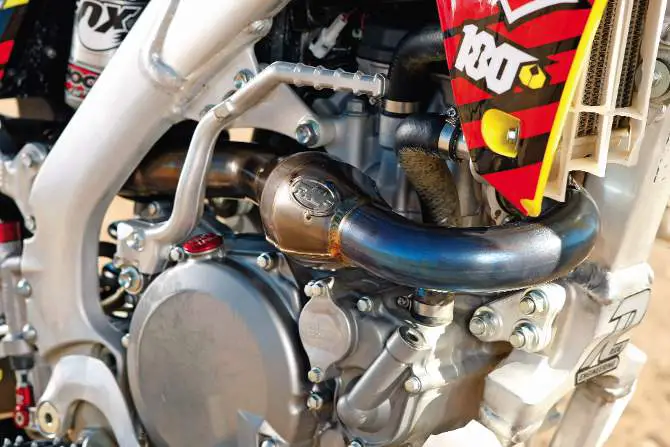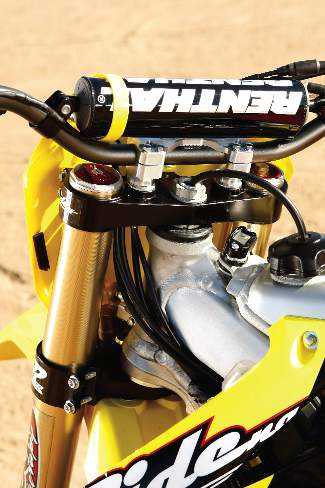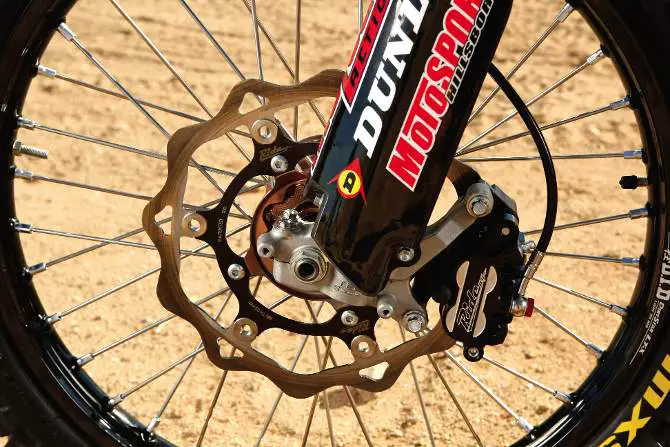WE RIDE RIDE ENGINEERING’S SUZUKI RM-Z450

The most important thing you should have learned after reading last month’s “MXA 450 Four-Stroke Shootout” is that there is no such thing as the “every-man bike.” Though the Kawasaki KX450F took top honors, all the bikes in the field have their bright spots?and their peccadilloes. Take the 2013 Suzuki RM-Z450. An incredible-handling bike, it lacked in the key areas of suspension, braking and power output. Is it a loser? Absolutely not. However, it would take a generous amount of money to maximize the RM-Z450’s potential.
Adrian Ciomo, owner of Ride Engineering, knows full well how the aftermarket business works. Adrian has been selling products for years, and mostly for popular bike brands. Those brands were Honda, Yamaha and Kawasaki. He shied away from developing parts for Suzuki riders. Why? Consumers won’t buy products for bikes they don’t own, and the last five years of Suzuki sales haven’t lit the aftermarket on fire. Ciomo wanted to expand his product line, but was befuddled by the fact that Suzuki’s share in the American motocross market was so small.
“I wanted to find out why the bike that James Stewart broke a multimillion-dollar contract to ride?the same bike that Mike Alessi rode to a strong second-place finish in the 2012 Nationals on?is the worst-selling brand for our in-house accessories,” said Adrian. So, Ciomo began creating products specifically for the 2013 RM-Z450, and he used Ryan Hughes as the chief test rider. After adding new items to the Ride Engineering catalog, Ciomo wanted to build MXA a bike that would showcase his hard work. Realizing that his products alone wouldn’t carry the freight, Adrian enlisted several companies to help in his quest to build a vastly improved RM-Z450. Scott Russell, owner of MotoSport Motorcycles in Hillsboro, Oregon, provided the 2013 Suzuki RM-Z450. Knowing that the suspension would need to be overhauled, Ciomo enlisted the services of his friend, Shock Therapy owner Steve Piattoni.

Ride Engineering’s Adrian Ciomo didn’t go overboard in modifying the RM-Z450. Instead, he showcased his growing line of products while getting aid from other aftermarket companies.
LET IT BE KNOWN THAT THE RIDE ENGINEERING SUZUKI RM-Z450 WASN’T TUNED TO THE BREAKING POINT. THAT WASN’T THE OBJECTIVE.
Let it be known that the Ride Engineering Suzuki RM-Z450 wasn’t tuned to the breaking point. That wasn’t the objective. Adrian Ciomo wanted to improve the suspension, handling and power while keeping an eye on durability. Granted, the cost of MXA’s bike build was around $5000, but there are cheaper alternatives that can be substituted for several of the modifications. Here’s the complete parts list for our purpose-built RM-Z450:
(1) Ride Engineering products. It’s understandable that Ride Engineering receives top billing. After all, it was Adrian’s idea to build the MXA test bike, and he put his nose to the grindstone to develop brand-new products for the RM-Z450. The laundry list of Ride Engineering parts included 20mm offset triple clamps with a built-in steering stabilizer, shock lowering link, oversize front rotor kit, billet brake caliper, ignition/timing plug kit, axle blocks, billet engine kill switch, 7/8-inch bar mounts, steel-braided brake line, banjo bolt kit, rear master-cylinder cover, an extension, brake clevis, and wheel spacers. The total bill for the Ride Engineering parts alone was $2171.10.
(2) Suspension. There has to be a motocross bike in the 450 class with the worst fork, and, for 2013, the Suzuki RM-Z450 justly earns the distinction. The shock isn’t far off for most riders, but the Showa SFF forks are atrocious. They aren’t ballpark for anyone under 230 pounds, yet heavier riders still complained about mid-stroke harshness. The reason? The forks are over-valved and have far too much oil.

The FMF?Racing MegaBomb header and Factory 4.1 RCT muffler are wise choices for 2013 Suzuki RM-Z450 owners.
Enter Steve Piattoni, owner of Shock Therapy in Pomona, California. Steve has been servicing suspension for 17 years. He was a hot-shoe Pro before throwing his hat into the suspension ring. Steve’s business isn’t as expansive as Pro Circuit’s, Factory Connection’s, Ohlins’ or Enzo’s, but that’s part of its charm. His one-man-band approach is great for SoCal riders looking for a truly personalized setup. Piattoni is willing to accompany a rider to a track and can revalve suspension on the spot. It’s that type of immediate service that convinced Adrian Ciomo to put his faith in Shock Therapy.
WE TESTED WITH STEVE PIATTONI FOR THREE DAYS, AND EVERY SETTING WAS BETTER THAN THE LAST. THIS WAS AFTER PIATTONI REMOVED A FORK-VALVE STACK THAT RESEMBLED A PILE OF SMARTIES.
Piattoni had a tall order to fill in, solving the plight of Suzuki’s Showa SFF forks. Making matters more difficult, Steve had little history with the 2013 RM-Z450, as the suspension is all new on the Zuke. But, he was up to the task, and we were more than happy to help him out with testing. After all, his success would be determined by our feedback. We tested with Steve for three days, and every setting was better than the last. This was after Piattoni removed a fork-valve stack that resembled a pile of Smarties.

Shock Therapy’s Steve Piattoni handled the suspension needs. He is an RM-Z450 fork whisperer. Piattoni did a great job.
Piattoni recently became affiliated with Fox Racing Shox; thus the Ride Engineering RM-Z450 had a Fox Podium RC3 shock, which we were initially leery about (from previous experience) but came to love. We’ve had trouble dialing in the Podium shock in previous tests, but Steve had the magic touch. After we voiced our desires, he went to work and zeroed in on a setting that was both plush and progressive. We couldn’t have asked for anything better.
(3) Engine. The MXA wrecking crew likes the 2013 RM-Z450 powerplant. The engine produces enough bottom-end torque to call the rider to attention; however, it’s not a world-beater. Ciomo wanted to spice up the package, so he enlisted the services of FMF Racing. They supplied a titanium MegaBomb header, along with a Factory 4.1 RCT muffler. Additionally, Bazzaz took care of custom mapping for the bike. On the dyno, the FMF exhaust and Bazzaz system improved power from idle to 6000 rpm, and again from 7000 rpm until sign-off. We used a Works Connection hour meter, mounted to the gas tank by the head tube, to monitor peak rpm and ride time on the bike.
(4) Controls. Renthal was charged with supplying the 7/8-inch, 971-bend handlebars; Kevlar half-waffle grips; and gold chain and sprockets (with stock gearing). The stock plastic throttle tube was replaced with a Works Connection aluminum throttle tube, and the stock clutch lever and perch were replaced with a Works Connection Elite unit. When ordering an Elite perch for your bike, make sure that you ask for the proper clutch-leverage ratio. MXA’s Ride Engineering bike had the wrong clutch throw, but we fixed that before melting the clutch plates.

We tested 22mm and 20mm offset Ride Engineering clamps. The 20mm offset was preferred on most tracks.
(5) Wheels. The gold TCR hubs mated with black D.I.D. LT-X rims added serious bling to the Ride Engineering RM-Z450 and strengthened the wheels to the point of Superman status. Red-anodized Ride Engineering wheel spacers were a nice touch. Dunlop provided their 80/100-21 MX51FA front tire, along with a 120/80-19 MX51 rear.
(6) Graphics. Bryar Perry of 180 Decals handled the cosmetic work. Bryar isn’t just the owner of 180 Decals; he also still finds time to race professionally. He very well might be the fastest graphics guy in the business, and he’s incredibly creative. We were immediately impressed with the yellow-and-red motif of the RM-Z450 graphics.
OUR FIRST ORDER OF BUSINESS WAS GETTING THE RM-Z450 SUSPENSION DIALED IN. STEVE PIATTONI ACCOMPANIED US TO THE TRACK OVER THE COURSE OF THREE TEST DAYS.
Our first order of business was getting the Ride Engineering RM-Z450 suspension dialed in. Steve Piattoni accompanied us to the track over the course of three test days. It was a blessing to have Steve on hand to tweak the suspension and revalve the forks right in the pits. Piattoni was aware of the challenges that lay ahead with the 2013 Suzuki RM-Z450 suspension. He tested the bike before it ever touched our hands and quickly realized that the stock suspension settings were dreadful.

The weak OEM?front brake was drop-kicked for an oversize Ride rotor, caliper and steel-braided brake line. It did the trick.
Upon dissecting the Showa SFF forks, he discovered a ton of mid-speed and compression valving. He took the normal valve stack and cut it down to about two-thirds of what Suzuki had used. A lot of the mid-speed and float were removed, and Piattoni softened the valve stack considerably. He also bumped up the spring rate to help keep the forks higher in the stroke.
Steve’s first stab at improving the RM-Z450 suspension was a big improvement over the stock settings, but MXA testers weren’t completely satisfied. The forks were now too high in the stroke, and midstroke harshness was still a problem. Quick to react, Piattoni installed the stock spring rate. It was the right move. With the forks dialed in, we turned our attention to the rear end of the Ride Engineering RM-Z450.
Piattoni just recently became a Fox Shox dealer and service center. Although he’s the RM-Z450 Showa shock whisperer, he wanted to use a Fox Podium RC3 shock for our test. The big difference between the two units is that the Fox shock has an anti-wallowing valve. This allows the rear end to stay up in the rollers and allows Steve to use much softer valving. We tried a stiffer shock spring, but it didn’t work in conjunction with the Ride Engineering lowering link. Although the link made the shock stroke more linear and dropped the rear end by 7mm, it stiffened the rate and was too stiff in the initial part of the stroke. Instead, we opted for a softer shock spring?5.5 kg/mm instead of the stock 5.7 kg/mm spring. It did the trick.
Gone were the stiffness and harshness that the 2013 Suzuki RM-Z450 suspension had become famous for. Shock Therapy did a remarkable job fixing the suspension woes, and we heartily recommend Steve Piattoni’s services to anyone dissatisfied with his stock suspension. We could blast through rough terrain with nary a worry, and the Piattoni-massaged suspension settled very well in corners.

Ride Engineering and Shock Therapy solved the numerous issues with the 2013 RM-Z450. We had a blast testing the bike.
Throughout the test we tinkered with different triple-clamp offsets. We tried the stock 21.5mm offset, followed by 22mm, and eventually settled on 20mm with the addition of a steering stabilizer. The 22mm Ride Engineering triple clamps performed well on high-speed tracks where traction wasn’t an issue; however, we noticed a vague feeling at turn-in on tighter tracks, so we went the other way with the 20mm clamps. The increased cornering capabilities were a bit much for a few test riders, but overall we preferred the Ride Engineering 20mm units. A word of advice: buy the optional steering stabilizer and bracket if riding on wide-open tracks. Otherwise, the front end will suffer from bouts of headshake in high-speed situations.
THE 2013 SUZUKI RM-Z450 HAS ARGUABLY THE WEAKEST BRAKES IN THE CLASS. AT 242 POUNDS, THE RM-Z450 IS A CHARGING RHINOCEROS WITH BB GUN-POWERFUL BRAKES.
As for the powerplant, the Ride Engineering RM-Z450 wasn’t a tricked-out pony. The FMF exhaust and the addition of a Bazzaz mapping device improved an already competitive engine. We noticed that the FMF exhaust added more bottom-end grunt, while the Bazzaz unit allowed the engine to be freer-revving. We didn’t touch the gearing, although adding a tooth to the rear sprocket would have been wise for tighter tracks.
The 2013 Suzuki RM-Z450 has arguably the weakest brakes in the class. At 242 pounds, the RM-Z450 is a charging rhinoceros with BB gun-powerful brakes. Adrian Ciomo wisely installed his Ride Engineering steel-braided front brake line, as well as his new 270mm, floating, oversized front rotor (developed with Galfer) and billet front-brake caliper with larger pistons. The all-new Ride Engineering brake caliper doesn’t flex; it allows air to flow through better, and the larger pistons provide more power with less effort. It was a great combination that allowed the RM-Z450’s inertia to be slowed considerably, giving testers the ability to drag the front brake through corners.
Ride Engineering’s Suzuki RM-Z450 is a testament to how good the stock 2013 bike could be if money was poured into improving the suspension, pepping up the powerband and getting the beast of a bike to stop. That’s exactly what Ride Engineering and Shock Therapy did. For more info, visit www.ride-engineering.com and www.shocktherapyracing.com.




Comments are closed.